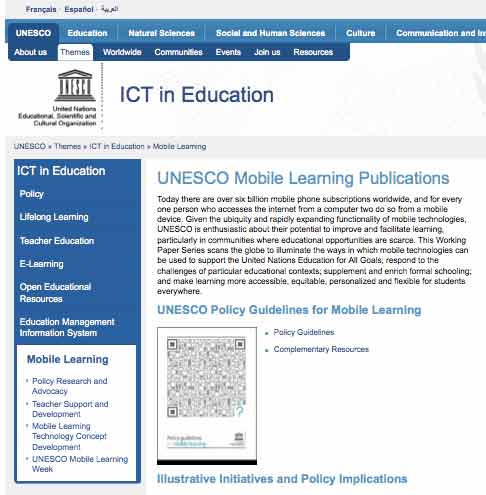Raymond Morel
4138 days ago

Resources to complement UNESCO Policy Guidelines for Mobile Learning
Adam, L., Butcher, N., Tusubira, F. F. and Sibthorpe, C. 2011. Transformation-Ready: The strategic application of information and communication technologies in Africa.
Education Sector Study. ICT Development Associates Ltd.
http:/
This study focuses on the experiences of Uganda, Senegal and South Africa in utilizing ICTs as a platform through which students and teachers can access learning resources more effectively. It was produced through a collaboration of the World Bank and the African Development Bank, with the support from the African Union.
Bassi, R. 2011. ICTs in Education (ICT4E): Policies and Plans worldwide, Version 8/Aug/11.
Nairobi, Global e-Schools and Communities Initiative (GESCI).
http:/
This working document provides an overview of all national and ministry-level plans and policies for the implementation of ICTs for education in several countries. It provides a rich-repository of blueprints for how ICTs can be integrated into education systems.
Greaves, T., Hayes, J., Wilson, L., Gielniak, M. and Peterson, R. 2010. The technology factor: Nine keys to student achievement & cost-effectiveness. Shelton, Conn., MDR.
Based on an analysis of the results of educational technology use within schools in the United States, this study considers the factors that lead to improved student achievement and higher cost-effectiveness. It finds that in terms of student achievement and cost-effectiveness schools using a 1:1 student-computer ratio outperform those that do not use a 1:1 ratio.
GSMA and A.T. Kearney. 2011. African Mobile Observatory 2011: Driving Economic and Social Development through Mobile Services. London, GSMA.
http:/
This report emphasizes the need for mobile operators and African governments to collaborate more closely to broaden access to mobile technology. It finds that superior access to affordable mobile services carry contingent benefits for education, healthcare, finance and communication.
GSMA Development Fund and Cherie Blair Foundation for Women. 2010. Women & Mobile: A Global Opportunity. A study on the mobile phone gender gap in low and middle-income countries. London, Authors.
http:/
This study highlights the barriers and opportunities associated with increasing access to mobile devices for women. Its findings are important because they indicate the potential that mobile technology carries to increase economic, educational and professional opportunities for women.
GSMA mWomen Programme, 2012. Policy Recommendations to Address the Mobile Phone Gender Gap.
http:/
This policy brief sets out a number of recommendations to governments and policy makers on how to empower women through mobile technology. The recommendations aim to address the barriers that result in the mobile phone gender gap in developing countries,
United Nations Educational, Scientific and Cultural Organisation (UNESCO), Japanese Funds-in-Trust, infoDev, AED, and Knowledge Enterprise, LLC. 2007. ICT-in-Education Toolkit for Policy Makers, Planners and Practitioners, Version 2.0. Washington, DC, World Bank.
http:/
The ICT-in-education toolkit provides policy makers with tools that help them plan, execute, and evaluate the use of ICTs in education.
Kukulska-Hulme, A. 2010. Mobile learning for quality education and social inclusion. Policy Brief. Moscow, UNESCO Institute for Information Technologies in Education (IITE).
http:/
In addition to articulating some of the key advantages and disadvantages of mobile learning, this brief also outlines best practices and recommendations for the sustainable inclusion of mobile technology in education.
United Nations Educational, Scientific and Cultural Organization (UNESCO). 2009. Policy Guidelines on Inclusion in Education. Paris, Author.
http:/
This document provides advice on how national governments can make education more inclusive and accessible to young people. The guidelines encourage the use of new technologies and ICTs where possible to facilitate more equitable access to education.
United Nations Educational, Scientific and Cultural Organization (UNESCO). 2011. Transforming Education: The Power of ICT Policies. Paris, Author.
http:/
Using multiple country case studies, this report offers insight into some of the policy approaches to and challenges of integrating ICTs in existing education systems. The report covers mobile technology in addition to fixed-line technologies.
United Nations Educational, Scientific and Cultural Organisation (UNESCO). 2012. UNESCO Working Paper Series on Mobile Learning. Paris, Author.
http:/
The UNESCO Working Paper Series on Mobile Learning includes 14 papers that explore the question of how mobile devices can be leveraged more effectively to improve educational access, equity and quality. It identifies ways in which mobile technologies can be used to achieve Education for All Goals and improving learning and teaching experiences in specific regional contexts.
World Bank. 2013. SABER-ICT ICT & education policies
http:/
